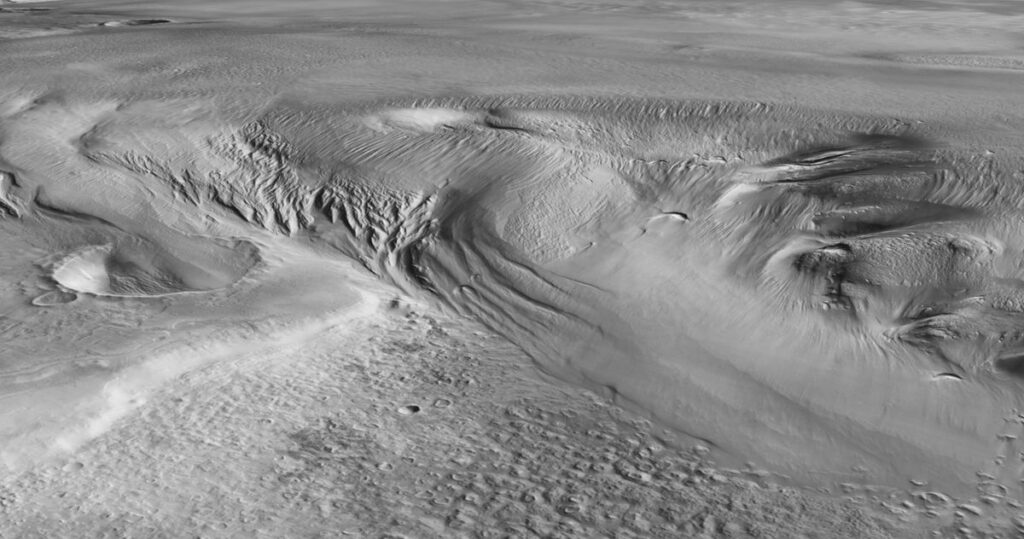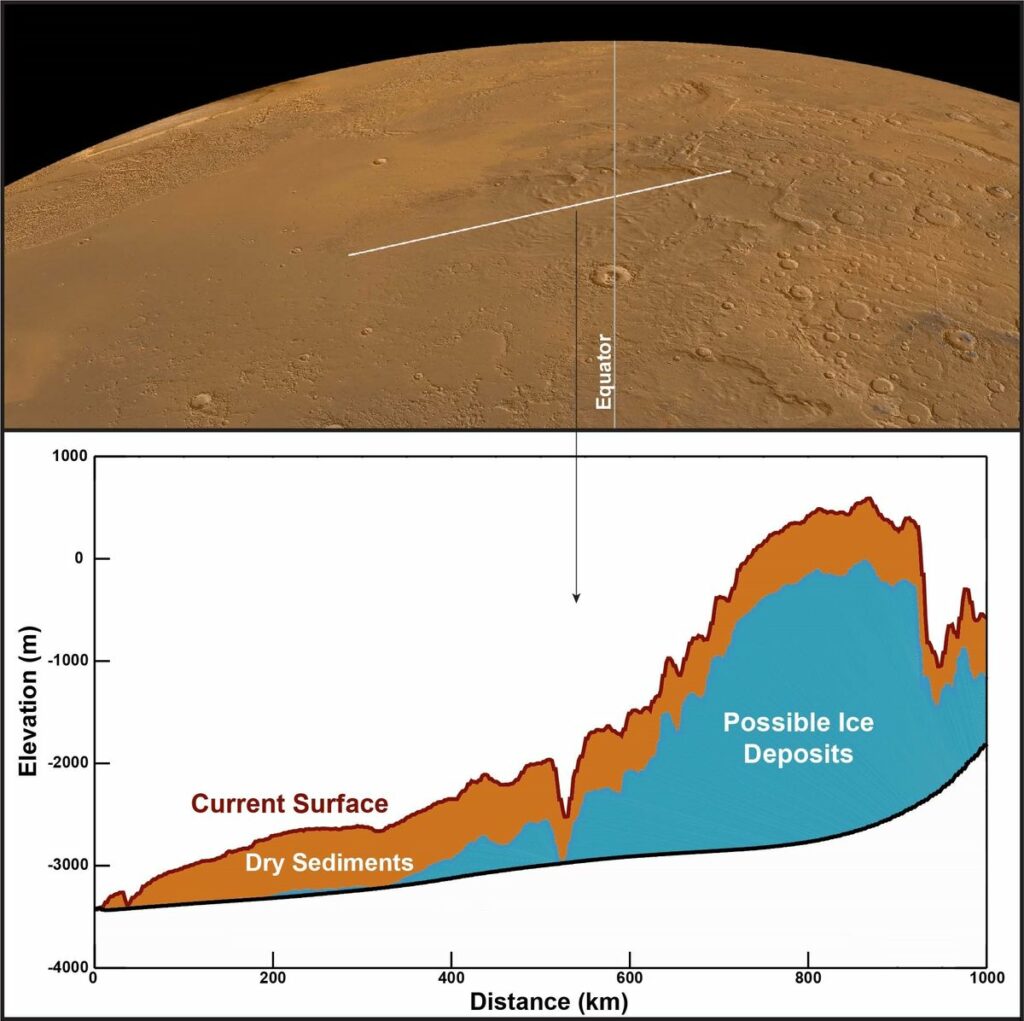The thickness of the water ice buried at the equator of Mars exceeds 2 miles.
The Mars Express Orbiter has measured the ground of the equatorial regions to be as much as 50 m deep ice, all could be melted turning the planet into a shallow ocean if thawed.
The ESA mission has just discovered that there is enough water seeping through the Martian soil to cover the entire planet with a Mile-and-a-Half-high’ ocean (1.5 – 2.7m), in the form of dusted ice beneath the polar cap.
Such result was delivered by Mars Express mission run by the European Space Agency (ESA). This has been a veteran spacecraft, having been working on science operations around Mars for the last two decades already. It however is not the first time that signs of ice remainade near the equator of Mars, but this new discovery is certainly the largest amount of water ice retraced so far and equally correspondent to the previous detection of ice on Mars.
“ASOMUYA, NASA’s Interstellar Mission: This mission’s first objective is to identify the cause. This is a much bigger challenge that requires great sensitivity because there is a high probability that the virus’s replication mechanism can be related to certain environmental and human factors.
The deposits are comparatively thick, extended 3.7km (2.3)miles underground and have crusted-over tops with hardened ash and sand/rock mounds that are hundreds of meters in height. There is no Eqt clear ice. Instead, it is is highly mixed with dust particles. The accessibility of the location, due to its proximity to the equator, is one of the advantages of the presence of the moon and being deep buried inside its structure, would however make it hard to exploit the water-ice for further crewed missions.
Some fifteen years back, the Mars Express discovered ice underneath the geological formation which goes under the name Medussa Fossae Formation (MFF). The matter of what the formations made of remained a mystery. Mars’ geography can be divided into two parts, high northern latitudes and low southern plains, and the MMF with a 5,000–km length lies in the zone of transition where the two parts merge.
It is estimated that the MMF itself was a product of lava acidity involving the destruction of the planet during an ancient time when Mars, was characterized by intense volcanic activity. Now its space fills with dust piles stretching many kilometers high — it is indeed the largest global source of the dust, the fuel for the giant storms that will sweep over Mars, as soon as season changes. I could not tell what our deposits were, whether some kind of dust or whether just a valley was filled with them.

Based on the latest data recorded by MARSIS under the surface by the subsurface radar onboard the Mars Express orbiter, Earth inhabitants now know what caused the Martian dust storms — and it’s not only dust.
“Considering how dense it is, if the inferred monster was merely a giant dust featuring a self-gravitational field it should have not exceeded a spherical dust cloud like a ball,” said Andrea Cicchetti of the National Institute for Astrophysics in Italy in a press statement. “Here we would form a more dense object than it would be because of the polynomials for the response we are using with MARSIS.”
Images may however seem blurry and concentrate in a low densely readable places, what is however what one would expect in case of water ice in the regions where MARSIS radar picks its data successfully.

However, the most important question, I think, is how the trade went, which makes the water ice present at the equator. Many identical previous missions found substantial amounts of sub-surface ice on Mars as well; one good example is when in 2008 NASA’s Phoenix mission unearthed the ice just below the mixed-up dirt levels at the lander’s chosen landing site in the poles. On the other hand, only a few years into the probe’s mission, Mars Express showed an abundance of water-ice extending down to middle latitudes, and NASA’s Mars Odyssey even found a hint that depth might have thawed in the farside in 2009.
ESA’s latest Trace Gas Orbiter instrumentation has, in their recent detection, picked heat of water ice which is just beneath the surface of Candor Chaos – a big regional section of the deep trench on Mars, which we call Vallis Marineris. Besides, relict glaciers belonging to the collapsed glaciers of ancient time, called as Relict glaciers, have been found by scientists in Eastern Noctis Labyrinthus, which touches the Southern Hemisphere near the equator from the north at 7.3° longitude.
Discovery that Mars boasted hydrological system with vast amounts of melted ice poles is the most solid proof of the fact that the Mars was drastically warmer in the remote past.
“These recent results revolutionise our perception of the MFF and shows similarly much is still unclear rather than clear cut,” notes Colin Wilson, who is an ESA project scientist for the Mars Express Spacecraft and also the Trace Gas Orbiter as per the statement. “Since when have lock deposits been that old and what were the conditions on Martian at that occasion?”
The fact that the ice could be here due to orbiting Martian axis does explain why the planet of Mars is how it is. A timeline of axial tilt changes across the Red Planet in the past indicate very chaotic change in the planet´s history. At present, Mars’ poles are tilted against the ecliptic by 25 degrees (with an obliquity of Earth is 23 degrees), though the past could have ranged from enclepsy to intense disorientation as the tilt could as shallow as 10 degrees and as extreme as 60 degrees.
On the other hand, two due to the Earth’s axial tilt, high obliquity leads to water-ice accumulation at the planet’s equator when the poles are pointing towards the sun. It was part of the process that perhaps it got covered by an eruption of the volcano, resulting in its entombment, which is still at play.
The periodic fluctuation of the tilt (obliquity) may be the mechanism for creation of the 400,000-year old traces found on Mars by the Chinese Zhurong rover, in addition to the presence of the gullies where water couldn’t be.
A new finding is described in a paper that the authors have recently published in a journal Geophysical Research Letters.
Do not forget to share your opinion with us to provide you with the best posts !




0 Comments